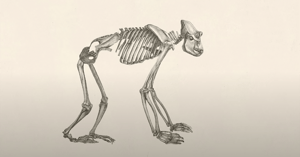What Makes Modern Humans Unique?
We take many aspects of human development for granted in the modern world, such as our capacity for rational thought, language, and culture. We don’t often think about our origins as a species, and the non-human species from which we evolved. However, the history of human origins is a fascinating one, and a look at this history sheds light on the nature and purpose of humanity. Beginning roughly 6 to 7 million years ago, the lineages leading to modern humans and modern chimpanzees diverged, revealing the origins of some of our distinct human qualities.
Hominins to Homo Sapiens
When looking at our ancestral fossils, a story begins to unfold in which the development of bipedalism, or upright posture, is a clear skeletal marker of hominin fossils, or the precursors for Homo sapiens. Meaning, about 6-7 million years ago, fossils indicate that these hominins were undergoing changes that made them more human-like. These early hominins had a brain size of about 350-400ccs, a bit larger than the size of a Coke can. Comparatively, modern Homo sapiens has developed to a brain size of roughly 1,300ccs.
The Beginning of Genus Homo
Jump to about 2.5 million years ago and we encounter the first evidence of members of our own genus, Homo habilis. Some notable characteristics of Homo habilis were a slightly increased brain size varying sizes in their heads and jaws as well as more human-like features in their face and jaw. Homo habilis was one of a number of African hominins, out of which Homo erectus emerged.
Homo Erectus to Homo Sapiens
Homo erectus was the first of the hominin species to leave Africa and it was the first to have a brain size that toped 1000ccs. Records show that of the species of Homo erectus left Africa over 1.2 million years ago, while other hominins such as Homo neanderthalensis emerged from Africa later, at 600,000 years ago. Eventually, modern humans emerged from the hominin poipulations that remained in Africa and then left Africa and spread throughout the globe 100,000 to 50,000 years ago. Thus, for many years waves of big-brained hominids were spreading out of Africa into the middle east, Asia, and beyond.
Purpose in the Evolution of Hominoids to Homo Sapiens
In this video, Dan Kuebler illustrates the progression of early hominins to Homo sapiens. The evolution of hominins to Homo sapiens is defined by complexity and mystery to this day. What we know is that Homo sapiens is the sole surviving species of the genus Homo. Although there were roughly 12 species of Hominids, Homo sapiens, the only species to have clearly develop rational conceptual thought, emerged from this diversity to create the first civilizations. While this progression has certainly been driven partly by natural selection and chance genetic mutations, it is also points to the unique nature of humanity and a purposeful behind the universe.

